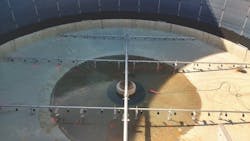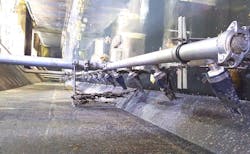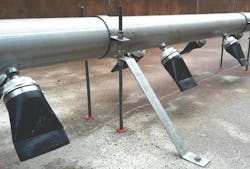The Modern Aerated Grit Removal Tank Design
Raw municipal wastewater contains mineral particles generally referred to as grit. These particles enter the collection system through influent and infiltration points (I&I), typically consisting of surface water runoff entering the system or sub-surface infiltration through manholes and pipe leakage.
As the particles move through the collection system, they become coated with organic material. The main purpose of a biological wastewater treatment plant is to treat organic material but it must first be separated from influent grit particles that cause excessive wear on treatment facility equipment. The earlier the grit particles can be removed in the treatment process, the less the equipment will be subjected to excessive wear.
Raw wastewater also contains larger debris and inorganic material, so the first stage of physical treatment is screening of debris. Grit particles in the stream are allowed to pass through screening equipment and grit removal equipment typically follows screening processes. As grit particles come in various sizes and densities, the removal equipment must be capable of removing a range of particle sizes. Specific wastewater streams should be sampled and analyzed to characterize the particle spectrum.
Storm events can produce different particle sizes in the stream outside of the standard characterization. Grit removal equipment should be designed with adjustment capabilities to address these specific events and variations. As previously noted, organics adhere to grit particles, so grit removal equipment must have a mechanism or method to wash these organics from the grit particles and be allowed to flow through to the biological treatment process. These grit removal processes must be capable of collection of the grit and removal from the structure so the particles can be disposed.
Historical Grit Removal Design Guidelines
The development of aerated grit technology resulted from observing existing aeration tanks that were utilizing a single roll loop mixing configuration of the tank fluid. This roll was achieved by installing diffused air manifolds along one side of the tank.
Through vertical rise of the discharged (buoyant) air, vertical hydraulic flow occurs through the eduction of hydraulic particles into the air flow path, inducing an overall circular movement (in section view) of the water body. During operation of these aeration tanks, it was observed that the heavier grit particles were being deposited at the opposite side of the hydraulic roll where the loop momentum was at its lowest point. Centrifugal forces contributed to allowing these heavier particles to drop out of the loop.
To prevent grit particle accumulation in aeration tanks, independent grit removal equipment was historically applied ahead of these processes. Based on this centrifugal removal method, aerated grit tanks were designed to generate a mixing loop with enough momentum to maintain suspension of the organic particles and to extend the range of the loop to allow for the hydraulic momentum to be low enough for heavier particle settling. As particle size and density decreases, so too does the requirement for hydraulic momentum, resulting in an extended time for settling to occur within the specific zone.
When developing the base geometric dimensions for a grit tank the following four aspects are applied:
- The cross-sectional area of the tank must be capable of handling the peak hydraulic flow rate of the treatment facility at an optimal linear velocity through the tank.
- The depth of the tank must be sufficient to allow adequate hydraulic vertical momentum to be achieved to generate the appropriate velocity of the mixing loop. Additional depth (below the mixing loop) is required for grit accumulation.
- The width of the tank shall be wide enough to provide a lower or dissipating hydraulic momentum zone for particle settling, but not too wide to allow organic particles to drop out of the loop.
- The overall length of the tank is based on the total mass of grit particles being loaded to the facility during the peak design hydraulic flow rate to the facility. While organic loading may not increase significantly during storm events, grit loading can increase during these events and should be accounted for in the mass loading design.
Equations and ratios for these design parameters are available in numerous engineering documents and regulatory guidelines and all were developed using particle settleability curves and in-situ operations with field acquired data. Most are defined as a range due to the averaging of the compiled data.
Enhanced Configurations Through Computer Modeling
Until recently, all aerated grit tanks were designed using historical equations and geometric ratios. These parameters are very basic and have limited guidelines for ancillary components within the structure, such as baffle walls used to enhance vertical momentum or induce particle separation. As a result, many systems have been designed by intuition and unverified performance results. With the development of computer modeling of hydraulics and fluid bodies (computation fluid dynamics or CFD), not only can the overall geometric ratios be evaluated but also these ancillary components can be validated and optimized.
With the large variation in existing grit tank configurations, CFD modeling has proven to be beneficial in optimization of existing facilities. CFD modeling has produced some basic design considerations that can be applied to the initial evaluation of existing structures and on proposed new system designs, as well as many special configurations that provide enhanced grit removal performance.
Some of the general recommendations developed include the following:
- Short circuiting of the longitudinal flow through the tank should be prevented. Short circuiting across the fluid surface is the most common path. Gaps in between the individual mixing loops can contribute as well as an unprotected overflow weir at the end of the tank. Surface baffling at the final discharge point located ahead of the final weir will prevent this surface short-circuiting from occurring.
- The velocity of the mixing loops must be adequate to carry the settled grit particles across the sloped floor surface to the collection zone. The particle density, floor slope and surface friction factor must be considered to ensure accumulation will not occur along this slope.
- Longitudinal baffles will increase the vertical hydraulic momentum in the diffused air discharge area. The distance of the baffle off the adjacent wall shall be adequate to allow for full expansion of the rising air curtain, but not far, which can result in hydraulic down-drafting in this vertical flow area. The area below and above this baffle must be sufficient to handle the mass hydraulic flow without restricting the momentum. The bottom of the baffle should also not extend down into the grit settling zone resulting in turbulence within this zone.
- Secondary baffling placed parallel to the longitudinal baffling and out in the mixing loop area has been applied in systems with the intent to segregate particles and induce multiple settling zones within a single mixing loop. These types of baffles have shown to be non-productive in particle segregation and only inhibit the overall momentum across the entire mixing loop distance.
- The influent and effluent tank geometry should be evaluated in reference to enhancements or restrictions to flow momentum within the grit removal area of the tank. Influent channels with sharp turns, 90 degree bends, etc., should be avoided as they can induce momentum loss and particle pre-settling. Methods to maintain momentum and even induce flow circulation should be considered. Effluent structures should allow for hydraulic storm surge and peak flow rates without reducing the linear velocity through the tank. Water levels in an aerated grit tank will vary due to hydraulic load variances, all conditions should be considered and evaluated for flow restriction potential.
Optimization of Modern Aerated Grit Removal System Design
The design of a new grit removal system or renovation of an existing system should contain the same design considerations. These design evaluations must consider variations in hydraulic flow rates, particle sizes and the total mass loading of these particles. The overall design evaluation should include the following rationale:
- A grit removal system should also provide a method for grit washing of the organics. This is typically achieved in the first zone of the grit tank where excessive diffused air is applied to generate high turbulence. This initial roll mix zone will keep the majority of the grit particles in suspension as it is designed for washing. An individual diffused air assembly with a throttling valve should be utilized to control the mass airflow into this zone.
- The next three zones of the grit tank should address removal of the three standard particle sizes found in raw wastewater. These three are categorized by their sieve size, the first is sieve 65 (and larger particles), the second is sieve 100 (medium sized particles), and the third is sieve 120 (silt particles). Each of these zones should have independent diffused air assemblies, each with a dedicated throttling valve. The throttling valve will allow for control of the total mass of air applied, which directly relates to the loop velocity achieved. The length of each of these zones—parallel to the flow direction through the overall tank—is based on the total mass loading of each particle group. A wastewater characterization study can determine these proportions. The final zone is an allowance for polishing and hydraulic surge during storm events and peak loading.
- Longitudinal baffling adjacent the air discharge curtain is recommended for optimizing the control loop velocity and momentum. The dimensional design of this baffle should be evaluated in section view for wall offset distance and clearance at the top and bottom for flow allowance.
4. Mechanical devises for removal of accumulated grit at the bottom of the tank come in multiple types, the common are pumped systems and screw auger systems. Clam shell and moving rake mechanisms have shown to be high in maintenance to keep in service.
Modern Aerated Grit Removal Tank Design Summary
With multiple new design considerations available for aerated grit removal tank design, consulting engineers and facility operators should consult with manufacturers who supply the process equipment within these systems. These manufacturers are frequently involved in the modeling processes being conducted on the designs of these grit removal systems and have incorporated many of the new aspects into their equipment.
When conducting CFD modeling of an aerated grit tank structure and the air distribution equipment, it is important to apply the correct expected performance conditions for these components otherwise the modeling can produce false or misleading results.
By using an engineering team with experience in CFD evaluations and studies of aerated grit tank systems conducted by consulting engineering firms, the end user can get accurate design representations of a new system. These teams of design engineers can provide complete aeration system design as well as guidance for the design and sizing of the ancillary components of the process.


